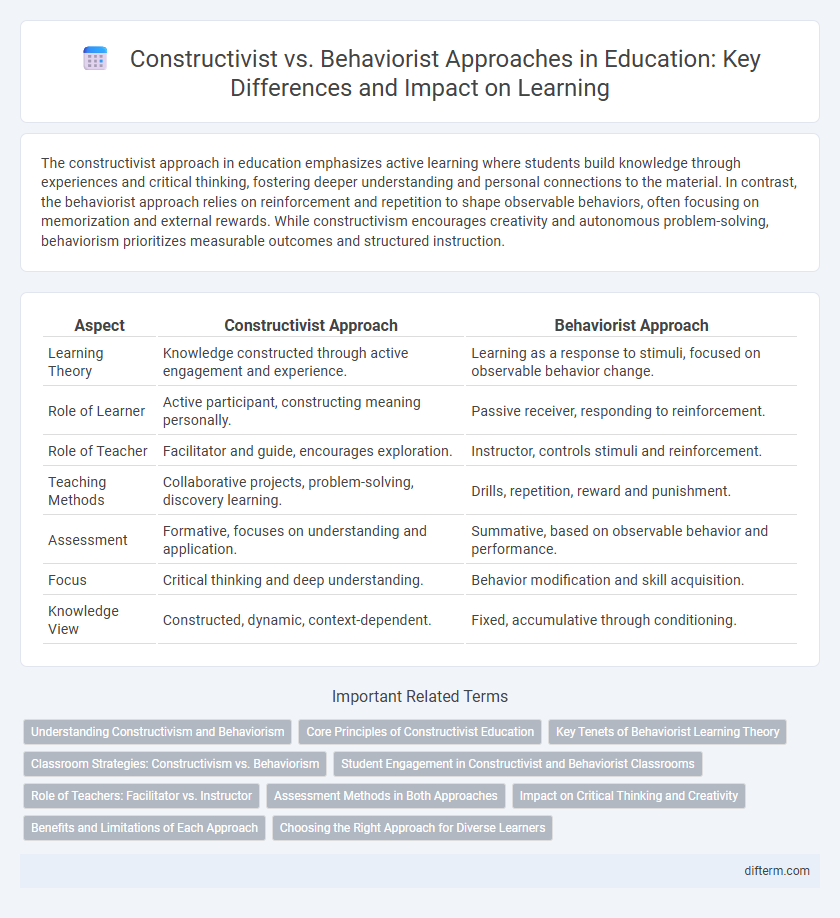The constructivist approach in education emphasizes active learning where students build knowledge through experiences and critical thinking, fostering deeper understanding and personal connections to the material. In contrast, the behaviorist approach relies on reinforcement and repetition to shape observable behaviors, often focusing on memorization and external rewards. While constructivism encourages creativity and autonomous problem-solving, behaviorism prioritizes measurable outcomes and structured instruction.
Table of Comparison
| Aspect | Constructivist Approach | Behaviorist Approach |
|---|---|---|
| Learning Theory | Knowledge constructed through active engagement and experience. | Learning as a response to stimuli, focused on observable behavior change. |
| Role of Learner | Active participant, constructing meaning personally. | Passive receiver, responding to reinforcement. |
| Role of Teacher | Facilitator and guide, encourages exploration. | Instructor, controls stimuli and reinforcement. |
| Teaching Methods | Collaborative projects, problem-solving, discovery learning. | Drills, repetition, reward and punishment. |
| Assessment | Formative, focuses on understanding and application. | Summative, based on observable behavior and performance. |
| Focus | Critical thinking and deep understanding. | Behavior modification and skill acquisition. |
| Knowledge View | Constructed, dynamic, context-dependent. | Fixed, accumulative through conditioning. |
Understanding Constructivism and Behaviorism
Constructivism emphasizes active learning where students build knowledge through experiences, promoting critical thinking and problem-solving skills. Behaviorism focuses on observable behaviors, using reinforcement and repetition to shape learning outcomes. Understanding these approaches highlights the contrast between learner-centered exploration and teacher-directed instruction in educational settings.
Core Principles of Constructivist Education
Constructivist education emphasizes active learning through exploration, reflection, and collaboration, encouraging students to build knowledge based on prior experiences. The approach prioritizes student-centered learning environments where critical thinking and problem-solving skills are developed intrinsically. Unlike behaviorist methods focused on memorization and reinforcement, constructivism supports deeper understanding by integrating real-world contexts and promoting meaningful knowledge construction.
Key Tenets of Behaviorist Learning Theory
Behaviorist learning theory emphasizes observable behaviors shaped through conditioning, using reinforcement and punishment as primary tools for motivation and learning. Key tenets include stimulus-response associations, repetition, and measurable outcomes, which guide structured, teacher-centered instruction. Unlike constructivist approaches that prioritize learner-driven discovery, behaviorism focuses on creating predictable, standardized learning environments to ensure consistent skill acquisition.
Classroom Strategies: Constructivism vs. Behaviorism
Constructivist classroom strategies emphasize active learning through exploration, collaboration, and hands-on activities that encourage critical thinking and knowledge construction. Behaviorist approaches focus on structured environments using reinforcement, repetition, and clear objectives to shape observable behaviors and improve skill acquisition. Both approaches leverage different techniques to optimize student engagement and learning outcomes based on cognitive involvement versus stimulus-response conditioning.
Student Engagement in Constructivist and Behaviorist Classrooms
Student engagement in constructivist classrooms is characterized by active participation, critical thinking, and collaboration, fostering deeper understanding through hands-on experiences and problem-solving activities. In contrast, behaviorist classrooms emphasize student engagement via repetition, reinforcement, and structured tasks, focusing on observable behaviors and mastery of specific skills. Research shows that constructivist environments promote sustained motivation and intrinsic interest, whereas behaviorist methods often yield immediate but short-term compliance and skill acquisition.
Role of Teachers: Facilitator vs. Instructor
In the constructivist approach, teachers act as facilitators who guide students to build their own understanding through exploration and interaction, fostering critical thinking and problem-solving skills. Conversely, behaviorist teachers function as instructors who deliver content, emphasize repetition, and use reinforcement techniques to shape desired behaviors and knowledge acquisition. This fundamental difference impacts classroom dynamics, with constructivist environments promoting active learning and behaviorist settings focusing on structured, teacher-led instruction.
Assessment Methods in Both Approaches
Assessment methods in the constructivist approach emphasize formative evaluation, encouraging self-reflection, critical thinking, and application of knowledge through authentic tasks and project-based assessments. The behaviorist approach relies heavily on summative assessments, such as standardized tests and quizzes, focusing on measurable changes in behavior and acquisition of discrete skills. Constructivist assessments aim to understand learners' cognitive processes, while behaviorist assessments prioritize observable and quantifiable outcomes.
Impact on Critical Thinking and Creativity
The constructivist approach enhances critical thinking and creativity by encouraging learners to actively engage, reflect, and construct knowledge through real-world problem-solving and collaboration, fostering deeper understanding. In contrast, the behaviorist approach relies on rote memorization and repetitive reinforcement, which limits opportunities for creative exploration and critical analysis. Research indicates that constructivist methods significantly improve students' ability to analyze, synthesize, and innovate compared to traditional behaviorist techniques.
Benefits and Limitations of Each Approach
The constructivist approach promotes active learning through hands-on experiences, fostering critical thinking and deeper understanding, but it may require more time and resources and can be challenging to standardize. The behaviorist approach emphasizes measurable outcomes through repetition and reinforcement, making it effective for skill acquisition and classroom management, though it may limit creativity and deeper cognitive development. Balancing both approaches can optimize learning by leveraging behaviorist structure with constructivist engagement.
Choosing the Right Approach for Diverse Learners
Constructivist approaches emphasize active learner participation and knowledge construction, fostering critical thinking and problem-solving skills essential for diverse classrooms. Behaviorist methods prioritize observable behavior changes through reinforcement, offering structured guidance beneficial for learners needing clear, consistent feedback. Educators must assess individual learner needs, cultural backgrounds, and cognitive styles to select the most effective approach that promotes inclusive and personalized education.
constructivist approach vs behaviorist approach Infographic

 difterm.com
difterm.com